Development and Validation of an AI-Based Risk Prediction Model For Osteoporosis in Post-Menopausal Women
DOI:
https://doi.org/10.59786/bmtj.317Keywords:
Osteoporosis, Post-menopausal women, Artificial intelligence, Risk prediction, Model validation, Bone mineral densityAbstract
Osteoporosis is a leading cause of morbidity in post-menopausal women. Timely risk stratification remains challenging despite available screening tools. To develop and validate an AI-based predictive model for osteoporosis in post-menopausal women. A hybrid approach combining clinical expertise with machine learning algorithms was used to develop the model. A dataset of 1,200 post-menopausal women (50-80 years) from three tertiary centers was used for training and validation. The final model demonstrated high accuracy (88.2%), sensitivity (90.1%), specificity (85.4%), and area under the receiver operating characteristic curve (AUC) (0.92). Key predictors included bone mineral density, BMI, years since menopause, serum vitamin D, and family history. This AI-based predictive model accurately identifies post-menopausal women at heightened risk for osteoporosis, enabling potential individualized treatment strategies and timely prophylactic measures. Further studies are needed to investigate model utility in larger, diverse cohorts.
Downloads
References
Cosman F, de Beur SJ, LeBoff MS, Lewiecki EM, Tanner B, Randall S, et al. Clinician’s guide to prevention and treatment of osteoporosis. Osteoporos Int. 2014;25(10):2359–2381.
Genant HK, Cooper C, Poor G, et al. Interim report and recommendations of the World Health Organization Task-Force for Osteoporosis. Osteoporos Int. 1999;10(4):259–264.
Johnell O, Kanis JA. An estimate of the worldwide prevalence and disability associated with osteoporotic fractures. Osteoporos Int. 2006;17(12):1726–1733.
Kanis JA, McCloskey EV, Johansson H, et al. European guidance for the diagnosis and management of osteoporosis in postmenopausal women. Osteoporos Int. 2013;24(1):23–57.
Kanis JA, Johansson H, Oden A, et al. Assessment of fracture risk. Osteoporos Int. 2008;19(4):385–397.
Leslie WD, Morin SN. Osteoporosis epidemiology 2013: implications for diagnosis, risk assessment, and treatment. Curr Opin Rheumatol. 2014;26(4):440–446.
Esteva A, Kuprel B, Novoa RA, et al. Dermatologist-level classification of skin cancer with deep neural networks. Nature. 2017;542(7639):115–118.
Obermeyer Z, Emanuel EJ. Predicting the future—big data, machine learning, and clinical medicine. N Engl J Med. 2016;375(13):1216–1219.
Rajkomar A, Dean J, Kohane I. Machine learning in medicine. N Engl J Med. 2019;380(14):1347–1358.
Kanis JA, Oden A, Johnell O, Johansson H, De Laet C, Brown J, et al. The use of clinical risk factors enhances the performance of BMD in the prediction of hip and osteoporotic fractures in men and women. Osteoporos Int. 2007;18(8):1033–1046.
Holick MF. Vitamin D deficiency. N Engl J Med. 2007;357(3):266–281.
Sambrook PN, Cooper C. Osteoporosis. Lancet. 2006;367(9527):2010–2018.
Pepe MS, Feng Z, Huang Y, et al. Integrating the predictiveness of a marker with its performance as a classifier. Am J Epidemiol. 2008;167(3):362–368.
Klazen CA, Verhaar HJ, Lohle PN, et al. Clinical course of pain in vertebral compression fractures. Osteoporos Int. 2010;21(6):945–954.
Schousboe JT, Shepherd JA, Bilezikian JP, Baim S. Executive summary of the 2013 International Society for Clinical Densitometry Position Development Conference on bone densitometry. J Clin Densitom. 2013;16(4):455–466.
Kirilova E, Kirilov N, Bischoff F, Vladeva S, Nikolov N, Nikolov M. Prevalence of low bone mineral density at axial sites and fracture risk in Bulgarian population. Orthop Rev (Pavia). 2022;14(no. 4):57622.
Johnson T, Fox E, Hassanbein S. Implementing an electronic medical record osteoporosis self‐assessment tool score which identifies patients at risk for osteoporosis promotes osteoporosis evaluation. Geriatr Orthop Surg Rehabil. 2021;12:215145932110021. doi:10. 1177/21514593211002157.
Kim SK, Yoo TK, Oh E, Kim DW. Osteoporosis risk prediction using machine learning and conventional methods. Proc Annu Int Conf IEEE Eng Med Biol Soc EMBS. 2013;14:188‐191. doi:10.1109/EMBC. 2013.6609469.
Kwon Y, Lee J, Park JH, et al. Osteoporosis pre‐screening using ensemble machine learning in postmenopausal Korean women. Healthcare. 2022;10(no. 6):1107. doi:10.3390/healthcare100 61107.
Nam KH, Seo I, Kim DH, Lee JI, Choi BK, Han IH. Machine learning model to predict osteoporotic spine with hounsfield units on lumbar computed tomography. J Korean Neurosurg Soc. 2019;62(no. 4): 442‐449. doi:10.3340/jkns.2018.0178.
He L, Liu Z, Liu C, et al. Radiomics based on lumbar spine magnetic resonance imaging to detect osteoporosis. Academic Radiol. 2021;28(no. 6):e165‐e171. doi:10.1016/j.acra.2020.03.046.
Published
How to Cite
License
Copyright (c) 2025 Juhi Deshpande, Chanchal Kumar Singh

This work is licensed under a Creative Commons Attribution 4.0 International License.
BioMed Target Journal is licensed under a Creative Commons Attribution License 4.0 (CC BY-4.0).







 BioMed Target Journal (ISSN: 2960-1428) is licenced under a
BioMed Target Journal (ISSN: 2960-1428) is licenced under a